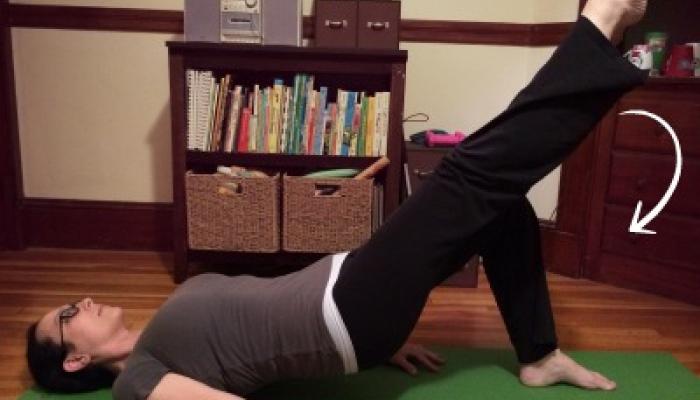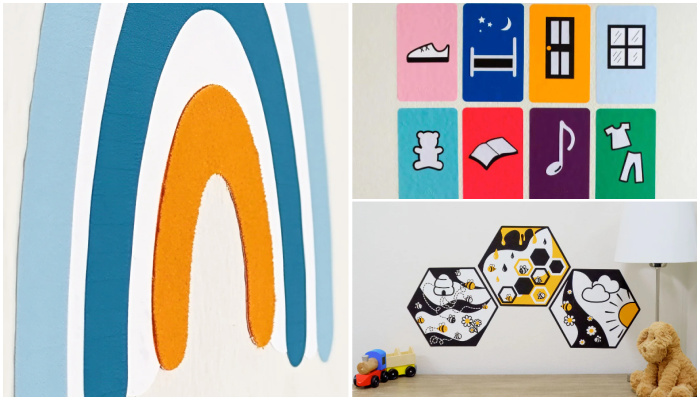14 Back Exercises for Caregivers

This post may contain affiliate links; please see our terms of use for details.
Caring for a disabled child can be stressful in many ways, but have you given much thought to how you might be placing stress on your back?
When your baby is little things might be simple – pick her up and off you go! But as she gets bigger if she still isn’t walking, well, you soon find out just how heavy 30 pounds really is! Then 40… then 50… Yikes!
One important thing to consider is lifting and transferring techniques. When you move your child from the bed to the wheelchair, for example, are you twisting and using your back or are you straight and using your legs?
Most likely your child sees a Physical Therapist either at home or at school, so reach out to them and ask for advice. They are there to help you! Have your PT give you advice on the best ways to move your child throughout the house or in and out of the car. If at all possible, have your PT visit you at home so they can see exactly where and how you are lifting your child. And check back in periodically as your child grows because the techniques you use for a 30 pound child may be different than the ones you want to use with a 40 pound child.
Your child’s PT would also be the best person to advise on equipment like belts or lifts that you may want to use for leverage. They’d also be the best person to assist in getting equipment covered through insurance!
Beyond technique you might also want to think about back strength. If your back and core are strong then you are less likely to injure yourself.
And yes, I say this from experience!
I injured my back lifting Ivan last summer and the pain was just terrible. I began seeing a Physical Therapist and he helped me develop an exercise plan that I can do every day at home with very little equipment. It’s helped tremendously!
Below is a description of the fourteen exercises I do every day. These have helped me strengthen my lower and upper back. Of course, these may not be the perfect exercises for you and you should always consult a doctor or Physical Therapist before beginning any workout, but these helped me so I wanted to share!
Equipment
These exercises require very few pieces of equipment (which is nice). Here is what I use:
- A yoga mat. It’s not totally necessary, but it is nice to have a soft surface, especially if you have hard wood floors.
- A large (75 cm) exercise ball.
- Two pound weights. If you don’t have the weights, cans of soup can work well too.
- Thera-Bands.
The Exercises
Once you get used to these exercises the entire routine should only take you about 30 minutes.
1. Bridge with Knee Extensions
Lay on the mat with your knees bent and feet flat on the floor. Find a neutral, comfortable position. Raise your bottom slowly off the floor until you are in a bridge position. While maintaining this bridge position, lift one leg off the floor and slowly straighten your knee. Keep your arms, neck and shoulder relaxed. Hold for 5 seconds, then return your foot to the floor but maintain the bridge position. Do the same with the other leg. Do 1 set (both legs) of 10 repetitions.

2. Bridge with Small Steps
Lay on the mat with your knees bent and feet flat on the floor. Find a neutral, comfortable position. Raise your bottom slowly off the floor until you are in a bridge position. While maintaining this bridge position, lift each foot approximately 4 inches off the floor in small marching steps. Use your buttock muscles to hold your pelvis while your legs move independently from your trunk. Do 1 set (both feet) of 20 repetitions.

3. Opposite Arm/Leg Dorsal Extension
Lie on your stomach with a small pillow under your pelvis. Stretch out your arms and relax. Lift one arm and the opposite leg, hold for 5 seconds, then relax. Repeat with the opposite arm and leg. Do 1 set (both sides) of 10 repetitions.

4. Bridge with Knees Extended with Ball
Lie on your back with your calves agains the ball and your arms along your sides and resting on the floor. Lift up your hips to a neutral position with straight knees. Hold for 5 seconds then return hips to the floor. Do 20 repetitions.

5. Opposite Arm/Leg Extension with Ball
Maintain a neutral spine position as you extend your arm and opposite leg. Hold this position for 5 seconds then alternate with the arm and leg. You can add your two pound weights to this exercise if you want an added challenge. Do 1 set (both sides) of 10 repetitions.

6. Back Extension with Ball
Keep the ball under your lower abdomen or pelvis and lift up onto the balls of your feet. Begin with your hands on the floor in front of you then lift your arms above your head and raise your trunk until you are in a neutral spine alignment. Hold for 5 seconds then return to starting position. You can add your two pound weights to this exercise if you want an added challenge. Do 10 repetitions.

7. Prone Horizontal Abduction with Ball
Begin with your hands on the floor to your side. Raise your arms out from the side bringing shoulder blades closer together. Hold for 5 seconds then return your hands to the floor. You can add your two pound weights to this exercise if you want an added challenge. Do 20 repetitions.

8. Prone Shoulder Extension with Ball
Begin with your hands on the floor to your side. Raise your arms up behind you bringing shoulder blades closer together. Hold for 5 seconds then return your hands to the floor. You can add your two pound weights to this exercise if you want an added challenge. Do 20 repetitions.

9. Wall Squat with Ball
Stand with your feet shoulder width apart and the exercise ball against your back between you and the wall. Slowly lower into a squat position, hold for 5 seconds, then return to standing. Do 20 repetitions.

10. Chest Pull with Band
Stand with your feet shoulder width apart. Loop the band around each palm and place your arms in front of your body with elbows slightly bent. Pull band outward and across chest, hold for 5 seconds, then return to starting position. Do 20 repetitions.

11. Scapular Retraction with Band
Attach the band to a door or bar. Loop the band around each palm and hold onto the band with arms held in front of you. Pull the band toward you while bending your elbows and squeezing your shoulder blades together. Hold for 5 seconds then return to starting position. Do 20 repetitions.

12. Extension with Band
Attach the band to a door or bar. Loop the band around each palm and hold onto the band with arms held in front of you. Pull the band toward you while keeping your arms straight. Hold for 5 seconds then return to starting position. Do 20 repetitions.

13. Hip Abduction with Band
Secure one end of the band to a couch leg or other immovable object and the other end to your ankle. Stand with your uninvolved leg next to the couch. Move your other leg away, keeping your knee straight. Hold for 5 seconds then return to starting position. Do 20 repetitions for each leg.

14. Hip Extension with Band
Secure one end of the band to a couch leg or other immovable object and the other end to your ankle. While facing the couch, pull one leg back, keeping your knee straight. Hold for 5 seconds then return to starting position. Do 20 repetitions for each leg.

Click here to download a pdf with pictures of all the exercises that you can use as a reference card.

Related Posts

Parenting
Sensory Wall Art: 5 Tips to Create a Room Your Blind or Low-Vision Child Will Love
Even if your child can’t see their surroundings, personalizing and decorating their room with thoughtful, sensory-friendly design can make a big difference in their confidence, independence, and joy.

Parenting
4 Tips to Manage Twins Alone as a Single Parent
Taking care of twins alone as a single parent can feel overwhelming. Learn practical ways to help lighten the load.

Parenting
How to Manage Twin Escalation Syndrome
Discover effective strategies for managing twin escalation syndrome, including promoting individuality and fostering positive interactions.